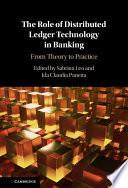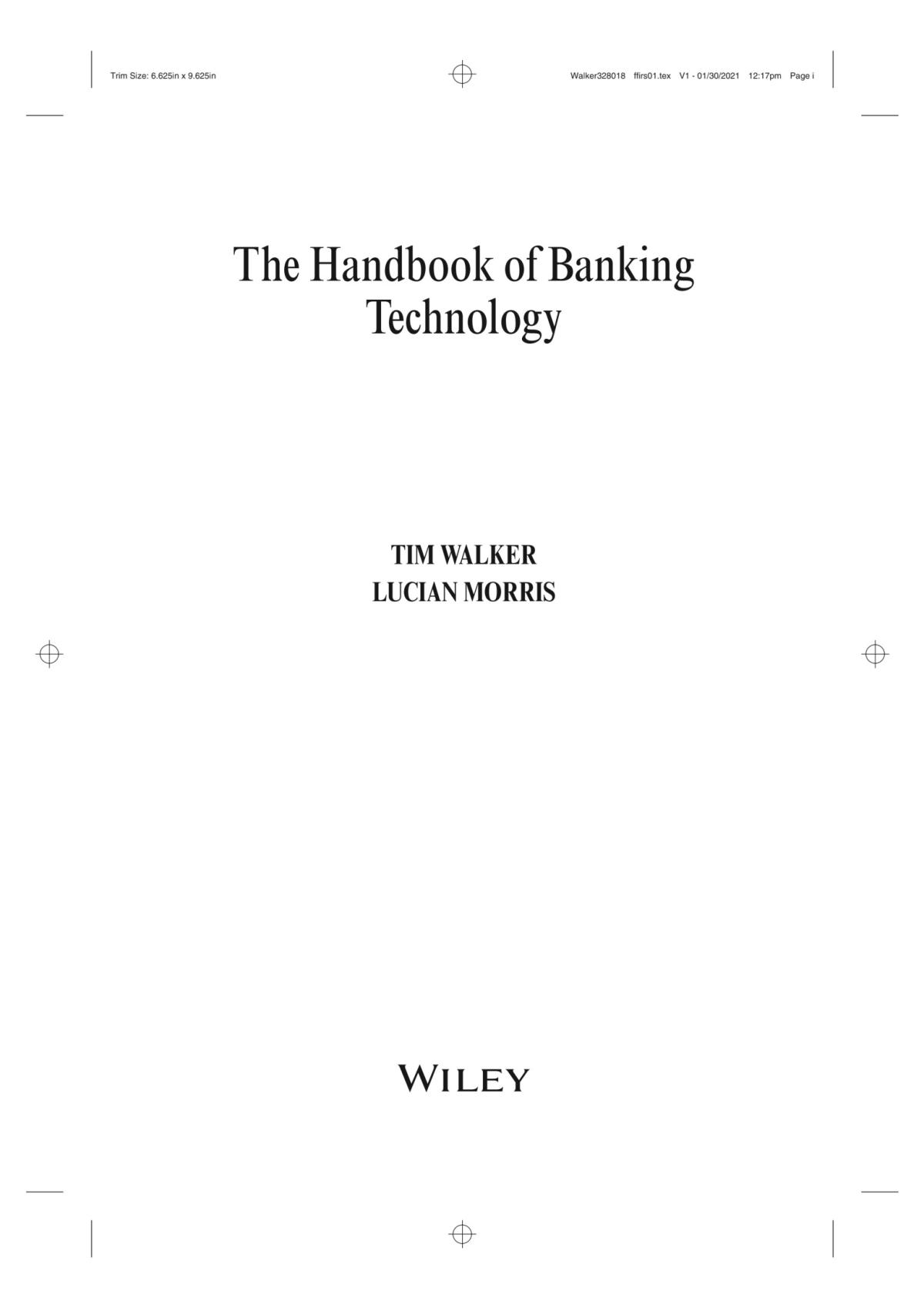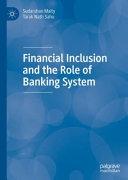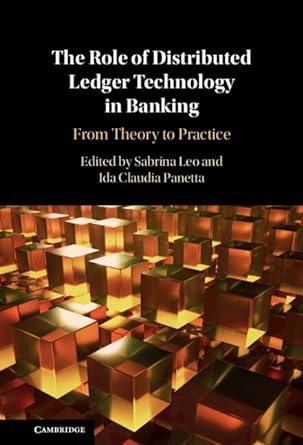The Role of Distributed Ledger Technology in Banking
From Theory to Practice
Edited by Sabrina Leo Sapienza University of Rome
Ida Claudia Panetta Sapienza
University of Rome
Shaftesbury Road, Cambridge CB2 8EA, United Kingdom
One Liberty Plaza, 20th Floor, New York, NY 10006, USA
477 Williamstown Road, Port Melbourne, VIC 3207, Australia
314–321, 3rd Floor, Plot 3, Splendor Forum, Jasola District Centre, New Delhi – 110025, India
103 Penang Road, #05–06/07, Visioncrest Commercial, Singapore 238467
Cambridge University Press is part of Cambridge University Press & Assessment, a department of the University of Cambridge.
We share the University’s mission to contribute to society through the pursuit of education, learning and research at the highest international levels of excellence.
www.cambridge.org
Information on this title: www.cambridge.org/9781009411745
DOI: 10.1017/9781009411783
© Cambridge University Press & Assessment 2024
This publication is in copyright. Subject to statutory exception and to the provisions of relevant collective licensing agreements, no reproduction of any part may take place without the written permission of Cambridge University Press & Assessment. First published 2024
A catalogue record for this publication is available from the British Library
A Cataloging-in-Publication data record for this book is available from the Library of Congress
ISBN 978-1-009-41174-5 Hardback
Cambridge University Press & Assessment has no responsibility for the persistence or accuracy of URLs for external or third-party internet websites referred to in this publication and does not guarantee that any content on such websites is, or will remain, accurate or appropriate.
Pat, Pat
List of Figures page ix
List of Tables xi
List of Boxes xii
List of Contributors xiii
Acknowledgements xviii
Introduction: The Banking in the Era of Distributed Ledgers 1
Sabrina Leo and Ida Claudia Panetta
Part I Why Pay Attention to Distributed Ledger Technology in Banking?
1 Blockchain and Distributed Ledger Technologies 11
Claudio Di Ciccio
2 The Integration of Distributed Ledger Technology in Banking: State of the Art in Literature 35
Sabrina Leo and Andrea Delle Foglie
Part II Opportunities and Challenges in Crypto-Asset Regulation
3 Some Reflections on the Proposed MiCA Regulation 71
Filippo Annunziata
4 Crypto-Assets in Banks: Between Opportunities and Legal Uncertainties 90
Andrea Daly
5 Cyberlaundering, VASPs’ Regulation, and AML Policy Response 114
Antonio Adinolfi and Emanuela Giusi Gaeta
Part III The Power of Distributed Ledgers in Payments
6 DLT in Payments: New Course of History Ahead?
Alessandro Agnoletti and Giancarlo Sfolcini
7 Central Bank Digital Currency: Rationales, Design Considerations, and Implementation Using the Algorand Blockchain Technology
Andrea Civelli, Co-Pierre Georg, Pietro Grassano and Naveed Ihsanullah
8 Opportunities, Challenges, and Design of CBDCs: The Italian Approach to a New Technology
Silvia Attanasio and Paola Del Vitto
9 A Proposal for an Asia Digital Common Currency (ADCC) Applying Distributed Ledger Technology (DLT) and Blockchain Technology (BCT)
Taiji Inui and Wataru Takahashi Part IV Enabling Financial Inclusion and ESG with Distributed Ledger Technology
Distributed Ledger Technology and Financial Inclusion
Harish Natarajan and Biagio Bossone
John Ho Part V A Further Look at DLT in Banking: Lessons Learned, Current Applications, and Future Scenarios
A Look into the Intermediaries of the Metaverse: Halfway between the Present and the Future
Ida Claudia Panetta and Sabrina
13 The DLT Landscape in Banking: Key Features of Prominent Use Cases through Strengths and Weaknesses
Sabrina Leo and Ida Claudia Panetta
1.1 A simplified example of Ethereum transaction page 13
1.2a A double-spending scheme 14
1.2b A double-spending scheme 14
1.3 Centralised and distributed architectures 15
1.4 A schematised view of the backward link–based chain of blocks 18
1.5 The Solidity code of a sample smart contract in Ethereum (Hello Token) 26
1.6 Invocation of a smart contract 27
6.1 Source of trust in different payment methods 138
6.2 Execution time and price volatility of different payment instruments 139
6.3 Crypto-payment in hands-off approach 145
6.4 Customer attitude towards crypto-payments 146
6.5 Split of transaction cost among the parties involved in crypto-payments 147
6.6a Theoretical e-money model 150
6.6b Actual implementation of e-money model 150
6.7 European market footprint of Nexi 153
8.1 Bank IT systems diagram 175
8.2 ABI Lab, conceptual diagram of the ABILabChain business zone 176
9.1a Yongle coin 190
9.1b Chinese 100 yuan 190
9.1c Japan 1 yen 191
9.1d 500 Taiwan dollar 191
9.2 Concept to issue ADCC 195
9.3 Asia Digital Common Currency (ADCC): issuing processes 195
9.4 Outline of electronic money transfer (payment) at merchant shops 196
9.5 Outline of transaction records by applying blockchain technology
9.6 Securing both countermeasures for criminal activities and anonymity
9.7 An image of issuing and distributing ADCC and digital wallet
9.8 Image of providing government bonds from each economy to AMRO
9.9 Image of issuing ADCC-denominated bonds using CSDs
9.10 Possible patterns of CBDC ledger
9.11 International remittance and cross-border payments using ADCC
9.12 Outline of electronic money (Suica) network
10.1a
10.1b An illustrative example of a distributed ledger system similar to Bitcoin (blockchain)
10.2a Adults without an account by economy (%), 2017
10.2b Adults without a financial institution account reporting barrier as a reason for not having one (%), 2017
10.3 Adults with an account (%), 2017
10.4 Constraints to financial inclusion and the development of digital financial
10.5
10.7
10.8 FinTech developments potentially relevant to the payment aspects of financial inclusion: the ‘PAFI Fintech Wheel’
13.1 Subjects involved in the settlement and clearing of orders when using an
1.1
2.1
2.2
2.3
2.4
2.5
2.6
2.7
2.8
2.9
2.10
6.1
6.2 Possible merchants’ approach in managing
13.1
13.2
13.3
13.4
1.1
11.5
11.6
Contributors
antonio adinolfi is a lawyer and lecturer at Scuola di Polizia Tributaria (Guardia di Finanza). Since 2003, he was Head of Unit (within the Treasury Department, DG Prevention of Use of the Financial System for Illegal Purposes, now DG Banking and Finance, Ministry of Economy and Finance). In 2015, he became a member of the G7 Cyber Expert Group. In 2018, he was appointed the co-chair of International Co-operation Review Group (ICRG)- Financial Action Task Force (FATF). In 2022, he became FATF Head of Delegation of Italy. In 2020, he became a substitute member of Financial Security Committee. Until 2020, he served as Director of the Central Means of Payment Anti-Fraud Office.
alessandro agnoletti is Head of Digital Currency & DLT at Nexi, with responsibility for positioning the company both in the field of digital currencies and in the application of DLT technologies to new inclusive and systemic payment solutions. He was previously Head of Innovation at SIA and has also held various roles in the areas of strategy and innovation at Bain & Company, H-Farm, and CDILabs, a startup he co-founded. Alessandro holds a degree in International Management from the Università Cattolica in Milan and an MBA from the Collège des Ingénieurs in Paris.
filippo annunziata is Associate Professor of Financial Markets and Banking Legislation at Bocconi University. He was Co-Director of the RULES Unit, Baffi-Carefin Centre, Bocconi University; Academic Board Member of European Banking Institute; Academic Member and Fellow of Jean Monnet Centre of Excellence EU Sustainable Finance and Law (EUSFIL); and Board Member of European Society for Banking and Financial Law (AEDBF) of Italy.
silvia attanasio is Head of Innovation in Associazione Bancaria Italiana (ABI) since May 2019 and Member of the ECB Digital Euro Market Advisory Group. She graduated in Statistical Science and
Economics. She worked for more than 15 years starting from its foundation in ABI Lab Consortium. Since 2017, she has been project leader for the Spunta project, an initiative of implementation of DLT applied to the interbank reconciliation process.
biagio bossone is Economist and a financial advisor to international institutions, national governments, and private sector financial institutions. He is also a banker and former central banker. He is the (co-)author of several studies and publications on economics, finance, and economic development.
andrea civelli is Associate Professor in Economics at the Walton College of Business (University of Arkansas) and former Senior Economist at Algorand Inc. Andrea’s research interests focus on monetary policy transmission and inflation modelling, with a particular interest in the role of the banking sector and business loan supply in the propagation of macroeconomic shocks. His research has been published in numerous economics and financial journals. Andrea received a PhD in Economics from Princeton University in 2010 and also held visiting positions at UT Austin and NC State University.
andrea daly is graduated in Law from ‘Università degli Studi di Torino’. After working as a lawyer, Andrea entered the Sella Group Compliance in 2015, specialising in investment services and then in crypto-assets regulation. Currently, he is Head of ‘Compliance Investment Services Research and Consulting & Digital Assets’ at Banca Sella Holding.
paola del vitto has worked in the Innovation Office of ABI since January 2020 until March 2023 following the evolution of the ECB project on the digital euro and other subjects concerning digitalization of Financial Institutions.
andrea delle foglie received a PhD in Banking and Finance (Sapienza University of Rome) and is currently Contract Professor at the Department of Law and Economics, University of Macerata and Postdoctoral Research Fellow in Banking and Financial Intermediaries at the Department of Management, Sapienza University of Rome. He focuses on the field of international financial systems, particularly the regulatory framework of the banking system, Islamic Banking and Finance, sustainable finance, and financial markets’ technology application.
claudio di ciccio is an associate professor at the Department of Computer Science at Sapienza University of Rome (Italy). His research spans across the domains of process mining, formal logics in AI, and blockchain technologies. He is Member of the Steering Committee of the IEEE Task Force on Process Mining.
emanuela giusi gaeta received a PhD in Political Economy Sapienza University; she was Researcher in Political Economy Tor Vergata University and Supervisor of Research Projects in Criminal Economy. She teaches courses on Political Economy, Political Economics, Monetary Economics, International Economics, Applied Economics, Criminal Economy, and Endogenous Growth course at the Research Doctorate. Her research areas are Cryptocurrencies Market, Energy-Saving Technologies, Technological Transfer, and Criminal Economy.
co-pierre georg is Associate Professor at EDHEC Business School. Previously, he held the South African Reserve Bank Research Chair at University of Cape Town. He is Director of the Algorand-UCT Financial Innovation Hub. Co-Pierre teaches courses on ‘Fintech and Cryptocurrencies’. His research interests focus on the nexus of financial innovation and financial stability. He obtained his PhD from the University of Jena in 2011 and has published both in finance and interdisciplinary journals. Co-Pierre’s research has received awards from the Algorand Foundation, the Ripple University Blockchain Research Initiative, the European Central Bank, and the Volkswagen Foundation. He has been a consultant at various central banks and held visiting positions at MIT, Oxford, Princeton, and Columbia University.
pietro grassano is Business Consultant in the Asset Management and Fintech space. He has been Business Solutions Director –Europe at Algorand between 2019 and 2022. At J.P. Morgan Asset Management from 2002 until 2019, Pietro has been Head of Sales for Italy, responsible for business in Greece, and Country Head for France. Having previously worked in BNP Paribas and Accenture, he has more than 20 years of experience in the asset management sector. He holds a master’s in economics and social sciences (DES) from Bocconi University in Milan.
john ho is Global Head of Legal, Financial Markets for Standard Chartered Bank. He is a mentor for the UK FCA Digital Sandbox
and is an active participant in the industry’s Fintech events and is a public speaker on topics such as Blockchain, Digital Assets, Financial Markets, Sustainability, and Regulatory Reforms.
naveed ihsanullah is VP of Engineering Research at Algorand where he focuses on future technology and features for Algorand’s blockchain platform. He is a senior engineering leader and technologist with more than 20 years of experience and continues to be fascinated by distributed systems and performance. Most recently of Mozilla, Naveed was instrumental in designing and leading the Quantum Flow program that focused 400 engineers to double Firefox’s performance in just one year. He also led the adoption of new technologies across all the major browsers (Chrome, Safari, and Firefox) to close the performance gap with native applications. These technologies include WebAssembly, SIMD.js, and Shared Array Buffer. Naveed is also previously of Carbon Black (then Bit9) where his teams developed nextgeneration application security software and cloud-based software reputation services. Passionate about improving how enterprises use technology, he has consulted on large organisational-level projects for Fortune 500 companies including Boeing Jeppesen.
taiji inui is proposing Asia Digital Common Currency (ADCC) with Professor Wataru Takahashi. He proposed a digital currency before Bitcoin. He is a JICA expert, an ADB consultant, and an ISO/TC68 member. He worked for BOJ and NTT Data developed payment infrastructures in Japan. He was also a member of BIS meetings.
sabrina leo , a PhD graduate in Banking and Finance, is Tenure Track Assistant Professor at Sapienza University of Rome. She is a lecturer in Strategies and Performance of bank accounts and Digital Banking. Her main research areas are DLT, Digital Payments, Digital Banking, and IT Governance in banks, and recently on the impact of technologies like AI/ML in the financial system.
harish natarajan leads a global team working on payments and market infrastructures topics in the Finance, Competitiveness, and Innovation Global Practice at the World Bank. His work spans Payments and market infrastructures, Financial Inclusion, Digital ID, Digital Economy, and FinTech. He represents the World Bank in several international working groups on these topics.
List of Contributors
ida claudia panetta , a PhD graduate in Banking and Finance, is Full Professor at the Sapienza University of Rome, where she teaches International Financial Markets and Institutions and Bank Economics and Management. Ida’s more recent research interests (and publications) regard the impact of new technologies in reshaping the financial system, focusing in particular on Mobile payment, DLTs, and Cybersecurity.
giancarlo sfolcini is a senior product manager within Digital Currency & DLT at Nexi, with focus on new business models enabled by emerging technologies. He has developed various experience leading innovation project in energy (ENI), telecommunications (BT), and managing consulting (EY).
wataru takahashi received MPhil in Economics from Oxford University in 1984 (Tutor; Prof. John Muellbauer, Nuffield). Prior to the current position, he had worked at the Bank of Japan for 35 years, mostly in academic research sections. He also worked for international affairs as an advisor to the Governor from 2001 to 2006.
Introduction The Banking in the Era of Distributed Ledgers
Sabrina Leo and Ida Claudia Panetta
Distributed ledger technology (DLT) refers to a decentralised and distributed digital system for recording and verifying transactions where multiple parties have access to the same database and can validate transactions without the need for intermediaries. A network of nodes maintains and updates the database, and transactions are secured through cryptography.
The conceptualisation of DLT can be traced back to the 1990s, but the first practical application of DLT was the creation of Bitcoin in 2009. Since then, DLT has evolved and expanded and is now being used in a wide range of industries. Among other sectors, the financial system as a whole, and banking in particular, have started to apply DLT to improve financial transactions and processes and to offer new products and services to their customers. In this sense, the financial system is going to be reshaped from the inside, in a process managed by the institutions that belong to it, exploiting the following main straights of DLTs:
– Security: DLT systems use cryptography to secure transactions and ensure that data cannot be altered retroactively.
– Transparency: They provide a shared ledger that is publicly accessible, making it easier to track transactions, and detect fraudulent activity.
– Efficiency: They can automate many manual processes, reducing errors and saving time.
– Decentralisation: They do not rely on a single central authority, reducing the risk of downtime and increasing the system’s resilience.
– Cost savings: They can reduce the need for intermediaries, reducing the cost of financial transactions and improving accessibility.
– Traceability: They provide a clear and transparent record of transactions, making it easier to track the movement of assets and prevent money laundering.
By improving the efficiency, security, and transparency of financial transactions, this technology has the potential to (i) streamline payment processing: DLT is being used to automate and streamline payment processing, reducing the time and cost of transactions; (ii) reduce redundancy of roles: DLT is being used to eliminate intermediaries in financial transactions, reducing the cost and increasing the efficiency of these transactions; (iii) improve security: DLT is being used to improve the security of financial transactions, reducing the risk of fraud and hacking; and (iv) provide more access to financial services: DLT is being used to create new financial services and to provide access to financial services to those who previously lacked access, such as the unbanked and underbanked populations.
Due to the potential to provide significant benefits to the financial system, many traditional banks, stand-alone or joining a consortium, are exploring ways to use DLT to improve their services and remain competitive. At the same time, DLT has the potential to pose a threat to the traditional banking system for several reasons. First of all, by enabling decentralised and peer-to-peer transactions, DLT may reduce the need for intermediaries and disrupt the traditional business models of banks. Furthermore, being a decentralised technology, DLT takes away from banks the control they traditionally exert on the financial system. Moreover, DLT, equally to the other disruptive technologies that are reshaping banking models in recent years, has the potential to create new players in the financial services industry, increasing competition for traditional banks.
Security concerns are a key issue in evaluating the threats of DLT in the financial sector. While this technology can improve the security of financial transactions, there is still a risk of cyberattacks and other security breaches, which could threaten the financial system’s stability. Finally, banking faces many regulatory challenges. Often, DLT operates outside of the traditional regulatory framework, and there are still questions about how this technology will be regulated and what impact this will have on traditional banks.
In light of the above, the position of DLT in banking can be seen as controversial as it is a rapidly evolving technology with both potential benefits and challenges. It is crucial for individuals and organisations to carefully evaluate the potential impact of DLT on the banking industry and to make informed decisions based on their risk tolerance and business objectives. Even current
literature is unable to provide a definite answer. The academic literature on DLT in banking typically takes a multi-disciplinary approach, incorporating computer science, finance, economics, and law insights. Some of the key themes that the academic literature addresses include:
– Technical aspects of DLT: many studies focus on the technical aspects of DLT, exploring how this technology can improve the efficiency, security, and transparency of financial transactions.
– Economic implications of DLT: other studies focus on the economic implications of DLT, exploring how this technology is changing the financial landscape and what this means for traditional banks and other financial intermediaries.
– Regulatory challenges: the academic literature also addresses the regulatory challenges posed by DLT, exploring the need for new regulatory frameworks to ensure that this technology is used safely and responsibly.
– Social and ethical implications: some studies also focus on the social and ethical implications of DLT, exploring the impact this technology has on society, and considering the ethical and social issues that must be addressed.
To explore the impact of DLT in the banking sector (as of December 2022), we offer the reader the opportunity to exploit different points of view of contributors pertaining to different disciplines. In doing so, the book attempts to combine theory and practice in two ways: (i) by involving academic contributors of international relevance, authors from regional and international institutions, and practitioners active in the financial system and (ii) by trying as much as possible to represent the topic in each chapter from both a theoretical and practical point of view, also highlighting concrete applications with the help of boxes. Aiming to create a more effective and engaging experience for the reader, the book is divided into the following five parts:
(i) Why pay attention to Distributed Ledger Technology in the banking? (Chapters 1–2)
(ii) Opportunities and Challenges in Crypto-Asset Regulation (Chapters 3–5)
(iii) The Power of Distributed Ledgers in Payments (Chapters 6–9)
(iv) Enabling Financial Inclusion and ESG with Distributed Ledger Technology (Chapters 10–11)
(v) A Further Look at DLT in Banking: Lessons Learned, Current Applications, and Future Scenarios (Chapters 12–13).
Going deeper into the book’s content, Chapter 1, authored by Di Ciccio, recalls the technical aspects of DLT and blockchain and their economic implications, which helps address and better understand the technical aspects addressed in the following chapters. Particular attention is paid to the technical features, essential procedures and guarantees, and implementation in a decentralised way. The advantages and disadvantages of this technology are also highlighted.
In Chapter 2, Leo and Delle Foglie, with a purely academic approach, conduct a thorough literature review to define the shape of research carried out by researchers on the topic, in the belief that scientific research can significantly contribute to finding solutions to address critical issues arising from banking, given its fundamental role in the growth of today’s market economies.
Chapters 3 – authored by Annunziata – and 4 – edited by Daly –present two different views on regulatory issues, the former more academic, the latter from a banker’s point of view. More in detail, Annunziata focuses on major concerns posed by the Markets in Crypto-assets Regulation (MiCA), and Daly underlines how regulatory uncertainty, stemming mainly from confusion regarding the legal classification of crypto-assets, hinders the provision of services by banks and increases risks for consumers and investors. Chapter 5, written by Adinolfi and Gaeta, discusses how the nature of Virtual Asset Service Providers (VASPs) can be used for criminal purposes; in this scenario, authors point out how regulation is necessary for the uncontrolled development of the illicit exploitation of a DLT as an upstream subject of VASPs, and the role of the Financial Action Task Force (FAFT) in orienting international actions to counteract cyber laundering phenomenon throughout VASPs.
DLT is largely used to transform the payment system. Chapter 6, co-authored by Agnoletti and Sfolcini, discusses how flexibility, transparency, and rapid scalability of DLT and cryptographic resources could revolutionise the finance and payments industry. The authors assert that the payments industry has an opportunity to innovate, particularly in cross-border, micro, and conditional payments.
Moreover, how, for this innovation to reach its full potential, existing high levels of risk and uncertainty must be addressed and a clear and shared regulatory framework developed between national and cross-border authorities. The authors post on the case of Nexi, which drives a safe and easy transition to a better society by promoting widespread inclusion, protecting all private and public stakeholders, and regulatory clarity.
The use of DLT allows for a decentralised and secure system for issuing and managing Central Bank Digital Currencies (CBDCs). Consequently, we devoted Chapters 7–9 to address the issue from several points of view.
Chapter 7, written by Civelli, Georg, Grassano, and Ihsanullah, covers three main themes. First, it identifies the difficulties a CBDC might respond to and reasons for understanding them better. Second, it examines ideal CBDC design concepts based on interviews with central banks, national and supranational authorities, market actors, and academics in different jurisdictions. Finally, it presents an Algorand-based retail CBDC system that fits these design standards. Chapter 8, written by Attanasio and Del Vitto, through an illustration of the Spunta DLT project, discusses how the Italian Banking Association has concretely brought licensed blockchain to the Italian banking sector through an infrastructure for banks operating in Italy that will be able to host other applications. Then, the chapter discusses the European Central Bank’s (ECB) ability to issue a CBDC and the Associazione Bancaria Italiana’s (ABI) position. This competition illustrates an experiment of the digital euro based on the DLT experience. While Chapter 9, by Taiji and Wataru, argues for introducing an Asian digital common currency (ADCC) as a multilateral synthetic currency that coexists with local currencies in the region. Using DLT, the issuance of ADCC is relatively simple, similar to how central banks today receive physical banknotes produced at the printing office. Each country’s central bank would then issue ADCC as its liability secured by ADCC-denominated bonds because ADCC is not each central bank’s legal tender and is distributed to national economies through commercial banks to be used for crossborder payments.
The book then focuses on the role of DLT in financial inclusion in Chapter 10, authored by Natarajan and Bossone. The authors analyse this potential, using the literature on the underlying reasons for
financial exclusion and what has worked, juxtaposing them with the benefits of DLT and how they might be relevant in addressing the underlying causes. The chapter describes the challenges in realising DLT’s potential and risks.
Ho, in Chapter 11, focuses instead on the fact that the popularity of digital assets and blockchain solutions is accelerating, exploring the environmental, social, and governance (ESG) impact of digital assets due to the growing participation of retail and institutional investors. For the author, blockchain technology can help financial institutions achieve favourable corporate ESG outcomes.
Chapter 12, co-authored by Panetta and Leo, looks into the metaverse’s intermediaries. The authors investigate that the metaverse is receiving significant attention from the banking industry because of its endless possibilities for virtual consumer interactions. As a natural progression of their sector, banks are interested in seeking the metaverse to develop stronger ties with their customers as they increasingly use technology to deliver their services. However, the value added for banks needs to be thoroughly analysed, and the absence of precise regulation may create reluctance. In addition, the metaverse may increase concerns about cybercrime in the financial and banking sectors. In the chapter, the authors examine banks’ approaches to the metaverse as a new method of using the promise of DLT and provide a framework summarising the development prospects (and risks) for financial intermediaries.
Finally, in Chapter 13, Leo and Panetta provide an overview of DLT in the banking sector, highlighting current problems and fundamental changes in the industry. To this aim, the chapter examines the major DLT projects and implementations in the banking sector, classifying them into two main categories based on the type of need being met-that is, products and services designed to meet the needs of customers of financial institutions and internal processes and operations aimed at meeting the needs of financial intermediaries. The authors, in the chapter, focus on the main characteristics of the prevalent use cases in the industry, highlighting strengths and weaknesses.
In light of the above, we hope the book could be a valuable source of knowledge and information on the role of DLT in the banking system. Unlike others in this contribution, we want to emphasise how DLT can be used to respond to new user needs and pressures from
competitors. DLT can represent an opportunity and not a threat to the banking system.
In a nutshell, the book looks at DLT not as a threat (as it did for banks in the first instance), not as a panacea (as it does for cypherpunks and blockchain enthusiasts), but as an exciting opportunity to bring the banking/financial system in the future (as scholars and academics should see it).
Part I
Why Pay Attention to Distributed Ledger Technology in Banking?












